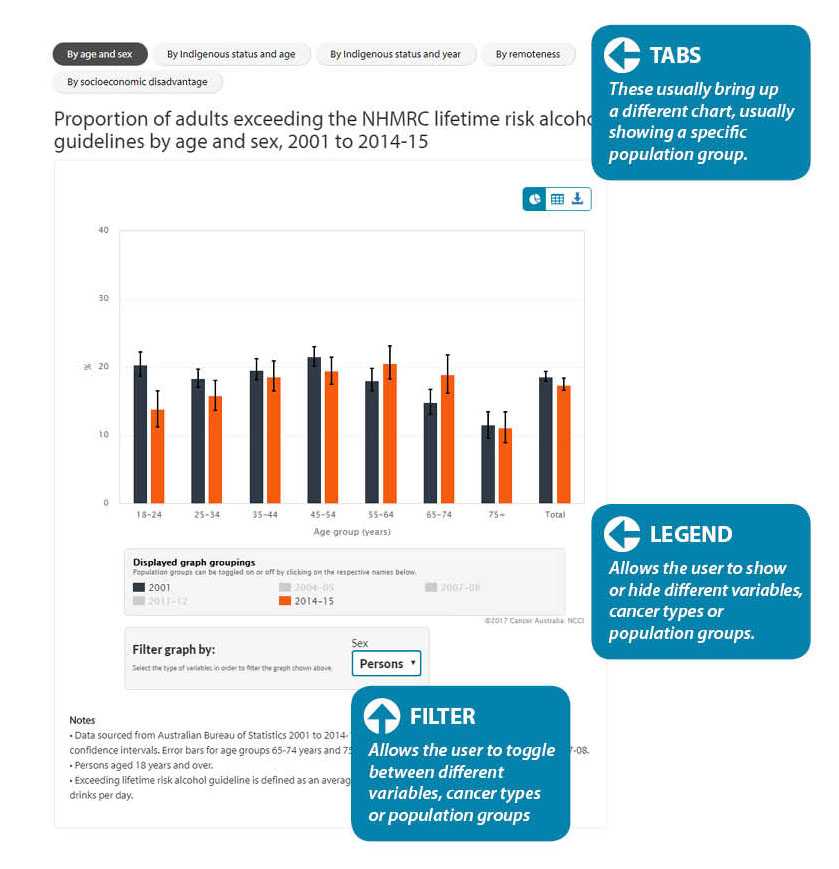The National Cancer Control Indicators (NCCI) have been developed to monitor and drive improvements in cancer control in Australia (refer to About the NCCI for more information).
Cancer control aims to reduce cancer risk, incidence, morbidity and mortality, and improve quality of life. NCCI uses the cancer control continuum as a guiding framework for reporting key cancer control indicators.
Data presented on NCCI represents currently available data sourced and collated in a coordinated approach involving Australia’s key national cancer data custodians. Links are provided to more detailed sources of data such as that available through the Australian Institute of Health and Welfare (AIHW) and Australian Bureau of Statistics (ABS).
NCCI provides national data for each cancer control indicator using the most current data available. It should be noted that there exists a large degree of variation in the availability and completeness of data for some cancer control domains, and for certain tumour types.
NCCI is designed to be updated as new data becomes available. Cancer Australia is working to improve the availability of national cancer data, and NCCI will showcase new data developments in national cancer control over time.
Comprehensive information about data sources, definitions and data caveats are contained under the 'About the Data' tab for each indicator. It is strongly recommended that users refer to this tab, especially when citing or downloading data used on the NCCI website.
With data from 15 authoritative sources, including the Australian Institute of Health and Welfare and the Australian Bureau of Statistics, NCCI initially establishes 7 domains, 31 indicators and more than 160 different data charts. These can be filtered to provide users with more than 500 different findings, delivering a population based picture of cancer control in Australia.
Cancer-related treatment data
Users are encouraged to read the introductory information here before reviewing the treatment indicator data.
Data relating to Aboriginal and Torres Strait Islander peoples
Cancer Australia acknowledges that there is no single Australian Aboriginal and Torres Strait Islander culture or group and that there are many diverse communities, language groups and kinships throughout Australia. However, when presenting data we will be respectfully using the term Indigenous Australians. Where comparator groups are presented (e.g. Other Australians; Non-Indigenous Australians etc.), the terminology used on this website is that originally employed by the respective data custodian.
Age-standardisation
Unless otherwise stated, data on the NCCI website have not been adjusted. For consistency and to ensure comparability, data has generally only been age-standardised where this is standard reporting practice by the relevant data custodian, or where recommended by external reviewers. Potential differences in age-structure should therefore be considered when comparing crude rates between population groups or over time.
Charts
Where data is available, each indicator provides one or more charts. The level of information can be selected by the user at three levels: by tab, by legend and by filter. This is illustrated below:

Users should check which 'Filter' option they have chosen when viewing data, as this may change when moving between charts.
Acknowledgements
Cancer Australia acknowledges the significant input of a large number of stakeholders who took time to review and provide input into the content on the NCCI website.
Cancer Australia also acknowledges the work of the many data custodians whose information is used on this website.
Finally, Cancer Australia would like to thank the NCCI Steering Committee, who guided the development of both the National Cancer Control Indicators and this website.